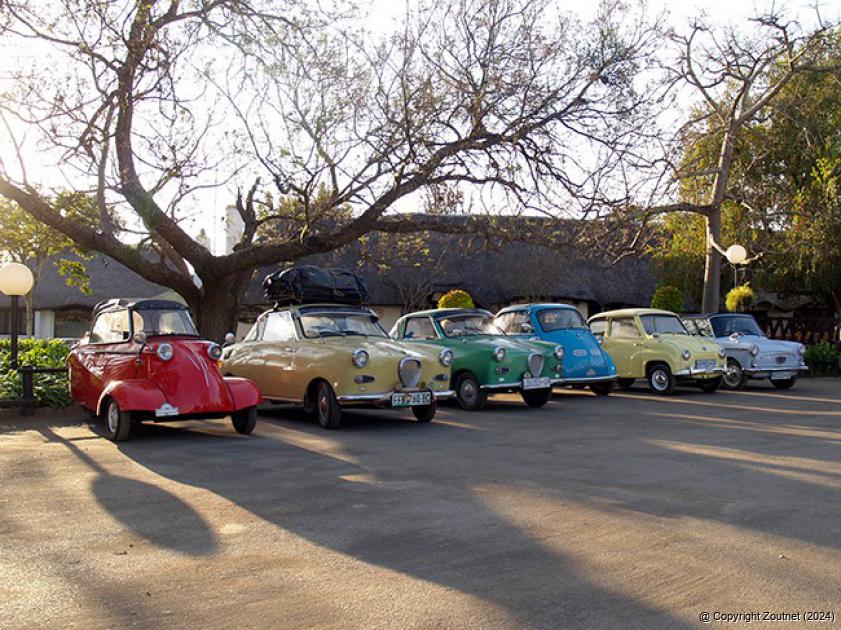

ADVERTISEMENT:

Microcars take Kruger by pleasant surprise
“We don’t stop for elephants,” remarked a visitor to the Kruger National Park last week. The reason was fairly obvious – his microcar may very well become a playful toy for one of these big giants, with less fun for the driver and passenger.
Luckily for the microcar enthusiasts, the elephants did not pay much attention to the herd of small cars passing them last week. The animals patiently watched from a safe distance as the cars puttered along with the usual bit of smoke bellowing out of the little two-stroke engines.
The SA Microcar Club celebrated its 25th anniversary with a trip through Limpopo and the Kruger National Park last week. Twelve of these little cars started off in Polokwane, from where the route took them past Tzaneen, Phalaborwa and into Letaba rest camp. The club then visited the camps in Shingwedzi, Mopani and Punda Maria and even had a picnic at Pafuri. On Friday, the group visited Tshipise and on Saturday they stopped over in Makhado (Louis Trichardt) on their way back.
Microcars are very collectable worldwide and there are active clubs in the UK, Germany, Australia and the USA. Normally, these cars have an engine capacity of no more than 700cc and date back to the pre-1970s. The South African club has members from across the country with a wide variety of small vehicles.
The cars that took part in the Kruger trip included names such as Goggomobil, Autobianchi, Messerschmitt and the famous “bubble car”, the BMW Isetta. They all date back to the 1950s and early 1960s, an era when the motor industry was on its knees after World War II. Car manufacturers had to be innovative and come up with affordable solutions for cash-strapped consumers.
The microcars are not only unique in their appearance; they also made a lasting contribution to the motor industry. Today’s BMW drivers should pay special tribute to the 300cc Isetta, as this little vehicle probably contributed most to the survival of this German motor manufacturer. In the period after the war, BMW had a limited range of products. The sports cars were not selling and people wanted more protection than what a motorcycle could offer. BMW then bought the patents for a little car from the Iso company and the bubble-shaped Isetta made its appearance in 1955. When production stopped in 1962, more than 160 000 of these little cars had been sold worldwide.
Just as the Isetta, each of the other cars added chapters to the motor industry’s history. When the 200cc Messerschmitt KR200 was launched in 1955, it broke 22 international speed records in its class at the Hockenheimring. It set a new 24-hour speed record when it averaged 103 km/h around the race track.
Last week’s trip, however, emphasized that bigger does not necessarily mean better. The small cars thrived on the uncluttered Kruger roads with the 50km/h speed limits. Although the microcars are not considered to be fast, most of them can easily cruise along at 70-80 km/h.
Much of the trip concerned the unique owners of these cars. Most of them rescued the cars from scrap heaps and spent years collecting bits and pieces to restore them. In most cases, the restoration process is a labour of love and the owners do not even bother to calculate how much they had spent on the cars.
For that reason it is very difficult to put a price on the cars. In Europe and the USA, the Isetta can easily sell for R200 000 or more, if it’s in showroom condition. The Goggomobils are less collectable (even though they are considered to be mechanically better cars), but even these models sell for more than R140 000 on US and European markets. In South Africa, however, the prices are much lower - that is to say, if you can get hold of one.
News - Date: 04 September 2014

Recent Articles
-

From sportscaster to advocate
21 April 2024 By Silas Nduvheni -

New lab welcomed by Bungeni learners
20 April 2024 By Thembi Siaga -

Rialivhuwa and Sally are king and queen
20 April 2024 By Kaizer Nengovhela -

'Headman demolished my house'
20 April 2024 By Kaizer Nengovhela
Search for a story:

ADVERTISEMENT


Anton van Zyl
Anton van Zyl has been with the Zoutpansberger and Limpopo Mirror since 1990. He graduated from the Rand Afrikaans University (now University of Johannesburg) and obtained a BA Communications degree. He is a founder member of the Association of Independent Publishers.

ADVERTISEMENT:


























